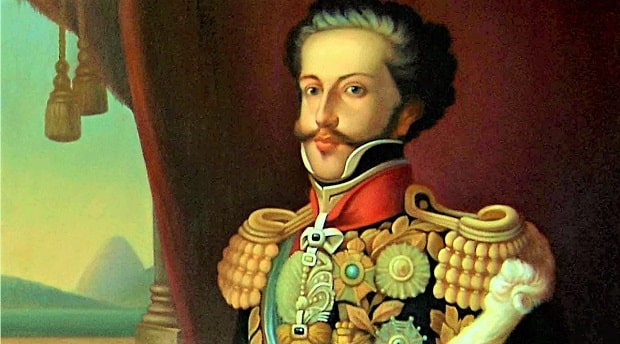Dom Pedro I is also known as Peter I (born on October 12, 1798, in Queluz, died on September 24, 1834, in Queluz) was the Emperor of Brazil from 1822 to 1831 and King of Portugal under the name Peter IV in 1826. He came from the Braganza house.
Dom Pedro I full name was, in Portuguese : Pedro de Alcântara Francisco António João Carlos Xavier de Paula Miguel Rafael Joaquim José Gonzaga Pascoal Cipriano Serafim .
Quick Facts: Dom Pedro I
- Known for: Declaration of independence of Brazil and to serve as emperor
- Also known as: Pedro de Alcântara Francisco António João Carlos Xavier de Paula Miguel Rafael Joaquim José Gonzaga Pascoal Cipriano Serafim, The Liberator, the King Soldier
- Born October 12, 1798, at the Queluz Royal Palace, near Lisbon, Portugal
- Parents: Prince Dom John (later King Dom John VI), Carlota Joaquina of Spain
- Died: September 24, 1834, at Queluz Palace, Lisbon, Portugal
- Prizes and distinctions: multiple Brazilian and Portuguese titles and honors
- Spouse (s): Maria Leopoldina, Amelie de Leuchtenberg
- Children: Maria (later Queen Dona Maria II of Portugal), Miguel, João, Januaria, Paula, Francisca, Pedro
- Notable Quote: “It grieves me to see my fellow man giving a man proper tributes to the deity, I know my blood is the same color as that of blacks. “
The Early Life of Dom Pedro I
Dom Pedro I or Peter I was born on October 12, 1798, at 8:00 a.m. in the Royal Palace of Queluz near Lisbon. He was given the honorary title “Dom” (Lord) from his birth. Through his father, Prince Johann (later King John VI), Peter I was a member of the House of Braganza (Portuguese: Bragança) and a grandson of King Peter III and Queen Maria I from Portugal, who were both uncle and niece as well as husband and wife.
His mother, Carlota Joaquina of Spain, was the daughter of King Charles IV of Spain. His parents had a very unhappy marriage. Carlota Joaquina was an ambitious woman who always tried to promote Spanish interests, even if they were detrimental to Portugal.
She was reportedly unfaithful to her husband and went so far as to plan to overthrow her husband with dissatisfied Portuguese nobles. As the second oldest son and fourth child, Pedro has declared heir to his father and prince of Beira due to the death of his older brother Francisco Antonio in 1801.
After Queen Mary was I. declared in 1793 for the terminally insane, took her son Prince John as regent government business on behalf of his mother. Until 1802, Pedro’s parents alienated more and more, so Johann in Mafra National Palace lived and Carlota Joaquina in Ramalhao Palace.
Pedro and his siblings, on the other hand, resided with their grandmother Maria I in the Queluz Palace, far from their parents, who they only saw in Queluz on state occasions.
Flight to Brazil
At the end of November 1807, the royal family fled to Brazil with nine-year-old Peter because a French invasion army sent by Napoleon was on the way to Lisbon. Napoleon wanted to punish the country for refusing to take part in the continental ban against England.
During the long and arduous journey, Peter Vergils read Aeneis and talked to the ship’s crew to acquire navigation skills. Pedro and his family arrived in Rio de Janeiro in March 1808, the capital of the largest and richest colony in Portugal, which was named the new residence.
Johann should Portugal until 1832, ie after a 24-year absence, re-enter. In Brazil, Peter, his younger brother Michael and his father settled after a short stay in the royal palace or St. Christopher’s Palace.
Although Dom Pedro I never had a very close relationship with his father, he loved him and disapproved of the constant humiliation that Johann had suffered from Charlotte Joachime’s extramarital affairs. In adulthood, Peter publicly titled his mother, for whom he only had feelings of contempt, as a “bitch”.
These early experiences of betrayal, cold, and neglect greatly influenced the formation of Peter’s character.
Independence of Brazil
The people of Brazil, who had had the privilege of being the seat of royal authority, did not much return to the status of the colony. Pedro followed the advice of his father, and also that of his wife, who wrote to him: “The apple is ripe: choose now, or it will rot. “Pedro declared independence dramatically on September 7, 1822, in the city of São Paulo. He was crowned Emperor of Brazil on December 1, 1822.
Independence was achieved with very little bloodshed: Portuguese loyalists fought in isolated places, but in 1824 the whole of Brazil was unified with relatively little violence. In this regard, Scottish Admiral Lord Thomas Cochrane was invaluable: with a very small Brazilian fleet, he drove with a combination of muscle and bluffing the Portuguese on Brazilian waters.
Pedro was skillful in dealing with rebels and dissidents. In 1824 Brazil had its own constitution and its independence was recognized by the United States and the Great -Brittany. On August 25, 1825, Portugal officially recognized the independence of Brazil; it helped that João was the king of Portugal at the time.

